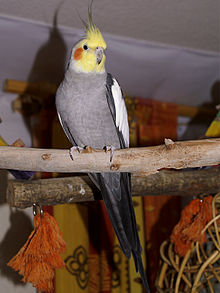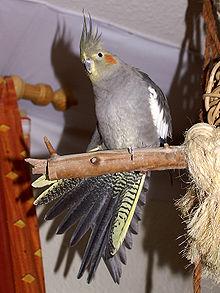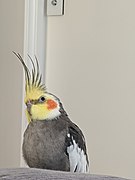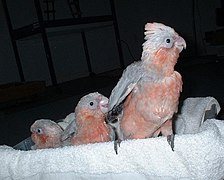Cockatiel
| Cockatiel | |
|---|---|

| |
| A male cockatiel. | |

| |
| A female cockatiel. | |
| Scientific classification | |
| Domain: | Eukaryota |
| Kingdom: | Animalia |
| Phylum: | Chordata |
| Class: | Aves |
| Order: | Psittaciformes |
| Family: | Cacatuidae |
| Subfamily: | Nymphicinae |
| Genus: | Nymphicus Wagler, 1832 |
| Species: | N. hollandicus
|
| Binomial name | |
| Nymphicus hollandicus (Kerr, 1792)
| |

| |
| Red: all-year resident | |
| Synonyms | |
|
Psittacus hollandicus Kerr, 1792 | |
The cockatiel (
The cockatiel is the only member of the
Taxonomy and etymology
Originally described by Scottish writer and naturalist
Its biological relationships were for a long time uncertain; it is now placed in a
Sequence analysis of
The cockatiel is now biologically classified as a genuine member of
Description
Appearance
The cockatiel's distinctive crest expresses the animal's emotional state. The crest is dramatically vertical when the cockatiel is startled or excited, gently oblique in its neutral or relaxed state, and flattened close to the head when the animal is angry or defensive. The crest is also held flat but protrudes outward in the back when the cockatiel is trying to appear alluring or flirtatious. When the cockatiel is tired, the crest is seen positioned halfway upwards, with the tip of the crest usually curling upward.[14] In contrast to most cockatoos, the cockatiel has long tail feathers roughly making up half of its total length. At 30 to 33 cm (12 to 13 in), the cockatiel is the smallest of the cockatoos, which are generally larger at between 30 and 60 cm (12 and 24 in).

The "normal grey" or "wild-type" cockatiel's plumage is primarily grey with prominent white flashes on the outer edges of each wing. The face of the male is yellow or white, while the face of the female is primarily grey or light grey,[15] and both sexes feature a round orange area on both ears, often referred to as "cheddar cheeks". This orange colouration is generally vibrant in adult males, and often quite muted in females. Visual sexing is often possible with this variant of the bird.
Sexual dimorphism
Most wild cockatiel chicks and juveniles look female, and are virtually indistinguishable from the time of hatching until their first
Adult cockatiels with common coloring (grey body with yellow head) are sexually dimorphic, though to a lesser degree than many other avian species. This is only evident after the first moulting, typically occurring about six to nine months after hatching: the male loses the white or yellow barring and spots on the underside of his tail feathers and wings. The grey feathers on his cheeks and crest are replaced by bright yellow feathers, while the orange cheek patch becomes brighter and more distinct. The face and crest of the female will typically remain mostly grey with a yellowish tint, and a less vibrant orange cheek patch. Additionally, the female commonly retains the horizontal barring on the underside of her tail feathers.
The colour in cockatiels is derived from two pigments: melanin (which provides the grey colour in the feathers, eyes, beak, and feet), and psittacofulvins (which provide the yellow colour on the face and tail and the orange colour of the cheek patch). The grey colour of the melanin overrides the yellow and orange of the psittacofulvins when both are present.
The melanin content decreases in the face of the males as they mature, allowing the yellow and orange psittacofulvins to be more visible, while an increase in melanin content in the tail causes the disappearance of the horizontal yellow tail bars.
In addition to these visible characteristics, the vocalisation of adult males is typically louder and more complex than that of females. But like most things this is not a hard and fast rule.
Colour mutations
Worldwide there are currently 22 cockatiel colour mutations established in aviculture, of which eight are exclusive to Australia. Mutations in captivity have emerged in various colours, some quite different from those observed in nature. Wild cockatiels are grey with visible differences between males and females. Male grey cockatiels typically have yellow heads while the female has a grey head. Juveniles tend to look like females with pinker beaks. The pied mutation first appeared in California in 1949. This mutation is a blotch of colour on an otherwise solid-coloured bird. For example, this may appear as a grey blotch on a yellow cockatiel.
Lutino colouration was first seen in 1958. These birds lack the grey of their wild counterparts and are white to soft yellow. This is a popular colour; due to inbreeding, these cockatiels often have a small bald patch behind their crests. The cinnamon mutation, first seen in the 1950s, is very similar in appearance to the grey; however, these birds have a warmer, browner colouring. Pearling was first seen in 1967. This is seen as a feather of one colour with a different coloured edge, such as grey feathers with yellow tips. This distinctive pattern is on a bird's wings or back. The albino colour mutation is a lack of pigment. These birds are white with red eyes. Fallow cockatiels first appeared sometime in the 1970s. This mutation shows as a bird with cinnamon colouring with yellow sections. Other mutations include emerald/olive, dominant and recessive silver, and mutations exclusive to Australia: Australian fallow, faded (west coast silver), dilute/pastel silver (east coast silver), silver spangle (edged dilute), platinum, suffused (Australian olive), and pewter. Other mutations, such as face altering mutations, include whiteface, pastelface, dominant yellow cheek, sex-linked yellow cheek, gold cheek, cream face, and the Australian yellow cheek.
Cockatiel colour mutations can become even more complex as one bird can have multiple colour mutations. For example, a yellow lutino cockatiel may have pearling – white spots on its back and wings. This is a double mutation. An example of a quadruple mutation would be cinnamon cockatiel with yellowface colouring with pearling and pied markings.[16]
-
Female pearl cockatiel
-
Two different-coloured male cockatiels
-
Female lutino cockatiel
-
1.5 year old male lutino cockatiel
-
A male white-faced cockatiel resting
Breeding and life span
Breeding is triggered by seasonal rainfall. Cockatiels nest in tree hollows near a source of fresh water, often choosing eucalyptus/gum trees. The hen lays 4-7 eggs, one every other day, which she incubates for 17–23 days. The chicks fledge after 5 weeks.[17] Cockatiels are the only cockatoo species which may reproduce by the end of their first year.
The cockatiel's average life span is 12 to 15 years,[18] though in captivity and under appropriate living conditions, a cockatiel could be expected to live from 16 to 25 years.[19] The oldest living and confirmed specimen of cockatiel was reportedly 36 years old.[20]
-
Egg, Collection Museum Wiesbaden
-
One-day-old cockatiel chick
-
Young fledged cockatiel
-
4.5-year-old male cockatiel
-
Three juvenile 'galatiels' (N. hollandicus x E. roseicapilla), a hybrid between a cockatiel and a galah
Distribution and habitat

Cockatiels are native to Australia, where they are found largely in
Speech and vocalization
Cockatiels are usually quiet parrots in contrast to others. They can be very vocal and learn many spoken words and phrases by mimicking. Usually, males are faster to learn speech, mimicking or singing; their calls are also more varied.
Cockatiels can also be taught to sing specific melodies, to the extent that some cockatiels have been demonstrated to synchronise their melodies with the songs of humans.[22] Without being taught how to both male and female cockatiels repeat household sounds, including alarm clocks, phones, tunes or other birds from the outdoors.[23][24][25]
See also
- Normal grey cockatiel
- Cockatiel colour genetics
- Companion parrot
- Pied cockatiel
- Lutino cockatiel
- Budgerigar
- White-faced cockatiel
- Cockatoo
- Bronze Fallow Cockatiel
References
- . Retrieved 12 November 2021.
- ISBN 978-0-008-28437-4.
- ISBN 978-0-85835-830-0.
- ISBN 978-0-643-10470-9.
- ISBN 978-1-4684-1893-4.
- ISBN 073222436-5.
- ^ "8 Best Medium-Sized Pet Bird Species". The Spruce Pets. Retrieved 2022-06-03.
- ^ a b c "Factsheets:Cockatiel". Australian Museum. Archived from the original on 2011-06-13. Retrieved 2008-08-30.
- ISSN 0102-0935.
- .
- JSTOR 4089461
- ^ Astuti, Dwi (2004): A phylogeny of Cockatoos (Aves: Psittaciformes) inferred from DNA sequences of the seventh intron of Nuclear β-fibrinogen gene. Doctoral work, Graduate School of Environmental Earth Science, Hokkaido University, Japan.
- ^ "Talking Birds".
- ^ "How to Understand a Cockatiel by His Crest". PetHelpful. Retrieved 2020-08-22.
- ^ Chua, Alex (25 August 2021). "How to Identify A Cockatiel's Gender". Clever Pet Owners. Clever Pet Owners. Retrieved 2 December 2021.
- ISBN 978-0-87605-178-8.
- ^ "Nymphicus hollandicus (Cockatiel)".
- ^ Pollock, Christal (2012). "Basic Information Sheet: Cockatiel". LafeberVet. Retrieved June 26, 2023.
- ^ Eleanor McCaffrey. "Cockatiels 101". cockatielcottage.net.
- .
- ^ "COCKATIEL (Nymphicus hollandicus)". World Parrot Trust. Retrieved 7 March 2022.
- PMID 34478436.
- ^ birdy (2022-05-28). "How to Get a Cockatiel to Like You [Proven Tips]". birdsology. Retrieved 2023-05-13.
- ^ "Cockatiels: Some of the Most Popular Pet Birds". The Spruce Pets. Retrieved 2024-01-07.
- ^ Doering, Laura (2013-05-16). "Cockatiel Sounds Explained – Pet Birds by Lafeber Co". Lafeber® Pet Birds. Retrieved 2024-01-07.
Further reading
- Astuti, Dwi (2004?): A phylogeny of cockatoos (Aves: Psittaciformes) inferred from DNA sequences of the seventh intron of nuclear β-fibrinogen gene. Doctoral work, Graduate School of Environmental Earth Science, Hokkaido University, Japan. PDF fulltext
- Dwi Astuti (2011). "Phylogenetic relationships within Cockatoos (Aves: Psittaciformes) Based on DNA Sequences of The Seventh intron of Nuclear β-fibrinogen gene" (PDF). Jurnal Biologi Indonesia. 7 (1): 1–11. ISSN 0854-4425.
- Flegg, Jim (2002): Photographic Field Guide: Birds of Australia. Reed New Holland, Sydney & London. ISBN 1-876334-78-9
- Martin, Terry (2002). A Guide To Colour Mutations and Genetics in Parrots. ABK Publications. ISBN 978-0-9577024-6-2.
- Hayward, Jim (1992). The Manual of Colour Breeding. The Aviculturist Publications. ISBN 978-0-9519098-0-5.
External links
 Quotations related to Cockatiel at Wikiquote
Quotations related to Cockatiel at Wikiquote- Cockatiels at Curlie
- Inte Onsman's MUTAVI Research & Advice Group
- Cockatiels – National Cockatiel Society
- Cockatiel Information Forum and Bulletin Board – Talk Cockatiels
- Videos, images and sounds – Internet Bird Collection











